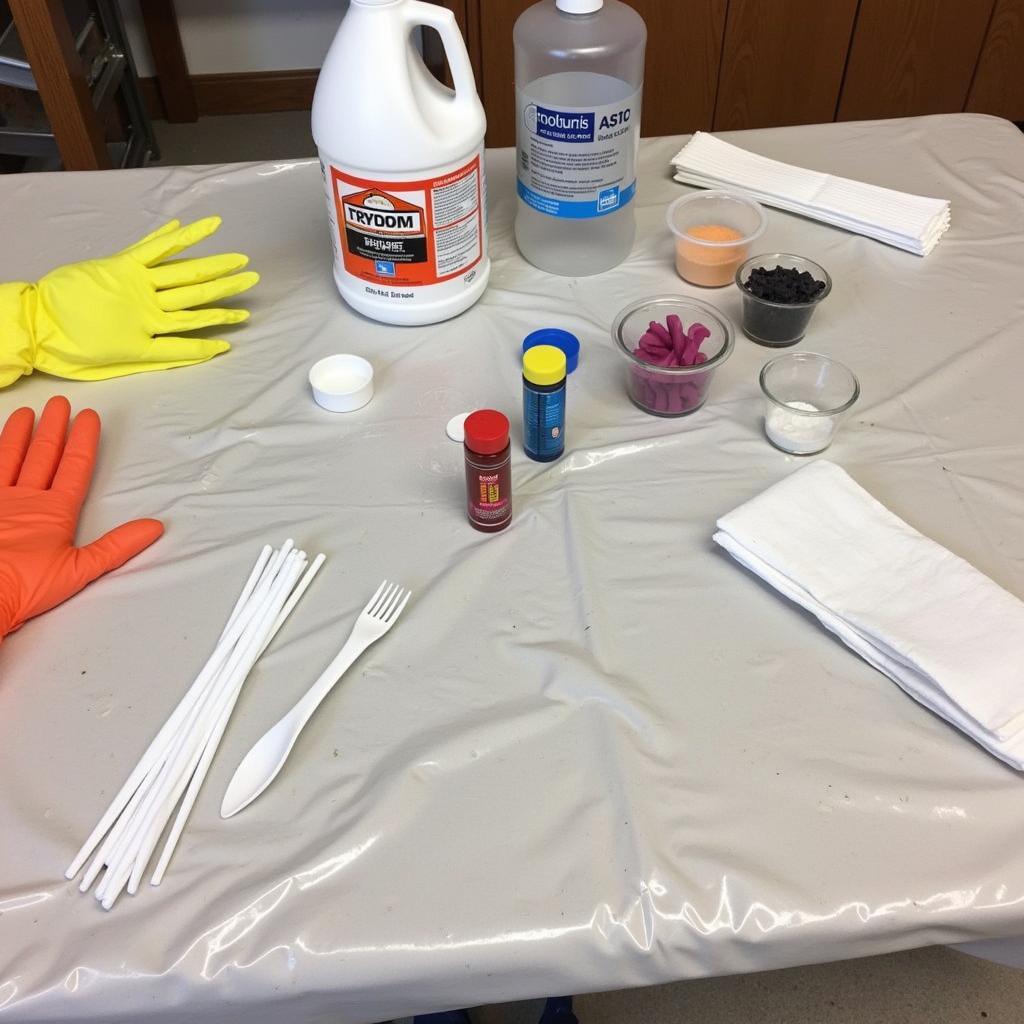Making slime is a fun and engaging activity, but the vibrant colors often come with a price: stained hands! This comprehensive guide will teach you how to color slime without staining hands, ensuring a mess-free and enjoyable slime-making experience. We’ll explore various coloring methods, tips, and tricks to keep your hands clean while creating colorful, vibrant slimes.
Choosing the Right Slime Base for Clean Coloring
The type of slime base you choose plays a crucial role in achieving stain-free hands. Clear glue slimes are generally easier to color evenly and are less likely to stain than white glue slimes. Consider using a pre-made clear slime base for optimal results and minimal mess. Alternatively, if you’re making slime from scratch, opt for a clear glue recipe.
Effective Coloring Methods for Stain-Free Slime
There are several methods for coloring slime without staining hands. Each method has its own advantages and disadvantages, so choosing the one that best suits your needs and resources is important.
Food Coloring
Food coloring is a readily available and affordable option. However, it can be messy if not handled carefully. The key is to add the food coloring to the slime ingredients before mixing. This prevents direct contact with the dye and reduces the risk of staining.
- Add a few drops of food coloring to your glue or liquid starch.
- Mix thoroughly before combining the ingredients to create your slime.
- This method ensures even color distribution and minimizes hand staining.
Liquid Watercolors
Liquid watercolors offer vibrant and intense colors. They are also less likely to stain than food coloring. Similar to food coloring, add the liquid watercolors to the liquid ingredients before mixing the slime.
- Dilute the liquid watercolors slightly with water to achieve your desired shade.
- Add the diluted watercolors to your glue or activator.
- Mix well before combining the slime ingredients.
Powdered Pigments
Powdered pigments, like mica powder or tempera paint powder, provide a wide range of color options and create unique effects. While generally less messy than liquid colors, take precautions to avoid inhaling the powder.
- Mix a small amount of powdered pigment with a few drops of glycerin or liquid activator to create a paste.
- Add the paste to your slime base and knead thoroughly until the color is evenly distributed.
- Wearing gloves is recommended when handling powdered pigments.
 Coloring Slime with Pigments
Coloring Slime with Pigments
Pre-Colored Slime Add-Ins
Another effective method to avoid stained hands is using pre-colored add-ins. These include glitter glue, pre-colored foam beads, or even small pieces of pre-colored slime.
- Simply incorporate the pre-colored add-ins into your clear slime base.
- This adds color and texture without any direct contact with dyes.
Essential Tips for Mess-Free Slime Coloring
Regardless of your chosen coloring method, follow these tips for a truly mess-free experience:
- Wear gloves: This provides an extra layer of protection against staining.
- Work on a protected surface: Cover your work area with a plastic tablecloth or wax paper.
- Use disposable utensils: Avoid staining your regular kitchen utensils by using disposable spoons, forks, or chopsticks.
- Clean up spills immediately: Address any spills promptly to prevent stains from setting.
 Mess-Free Slime Coloring Setup
Mess-Free Slime Coloring Setup
Troubleshooting Common Slime Coloring Issues
Sometimes, despite your best efforts, you might encounter issues like uneven coloring or unwanted staining. Here are some solutions:
- Uneven coloring: Knead the slime thoroughly for several minutes to distribute the color evenly. If the issue persists, add more color in small increments.
- Slight hand staining: Wash your hands immediately with soap and warm water. For stubborn stains, try using a gentle exfoliating scrub.
Conclusion
Coloring slime without staining your hands is entirely achievable with the right techniques and precautions. By choosing the right coloring method, following the provided tips, and addressing potential issues proactively, you can enjoy a mess-free and colorful slime-making experience. So, gather your supplies, choose your favorite colors, and start creating vibrant, stain-free slimes!
FAQs
-
What is the best type of glue for making slime? Clear glue is generally recommended for slime making, especially when aiming for vibrant colors and minimizing staining.
-
Can I use acrylic paint to color slime? While possible, acrylic paint can make the slime stiff and is more likely to stain.
-
How do I fix slime that is too sticky? Add a small amount of liquid starch or activator, a teaspoon at a time, until the desired consistency is achieved.
-
What can I do if my slime is too stiff? Add a few drops of water or glycerin to soften the slime.
-
How do I store slime? Store your slime in an airtight container at room temperature to prevent it from drying out.
-
Can I add glitter to my slime? Yes, glitter is a popular addition to slime and can enhance its visual appeal.
Situations involving frequent questions:
-
My slime is too sticky after adding color. This can sometimes occur if the coloring agent adds extra moisture. Gradually add more activator, kneading well after each addition, until the stickiness is reduced.
-
My hands are still slightly stained even after washing. Try using a mild soap and warm water along with a gentle scrubbing action. Lemon juice or baking soda can also help remove stubborn stains.
-
The color isn’t as vibrant as I expected. If using food coloring, try adding a few more drops. With pigments, ensure they are thoroughly mixed into the slime base.
Other suggested questions and related articles:
- How to make fluffy slime without borax?
- Best slime recipes for beginners
- How to store slime to prolong its lifespan?
- Creative slime add-ins and decorations
Need Help? Contact Us!
For further assistance or personalized advice on slime making and coloring, don’t hesitate to contact our team. Call us at 0373298888, email us at [email protected], or visit us at 86 Cau Giay, Hanoi. We offer 24/7 customer support.

